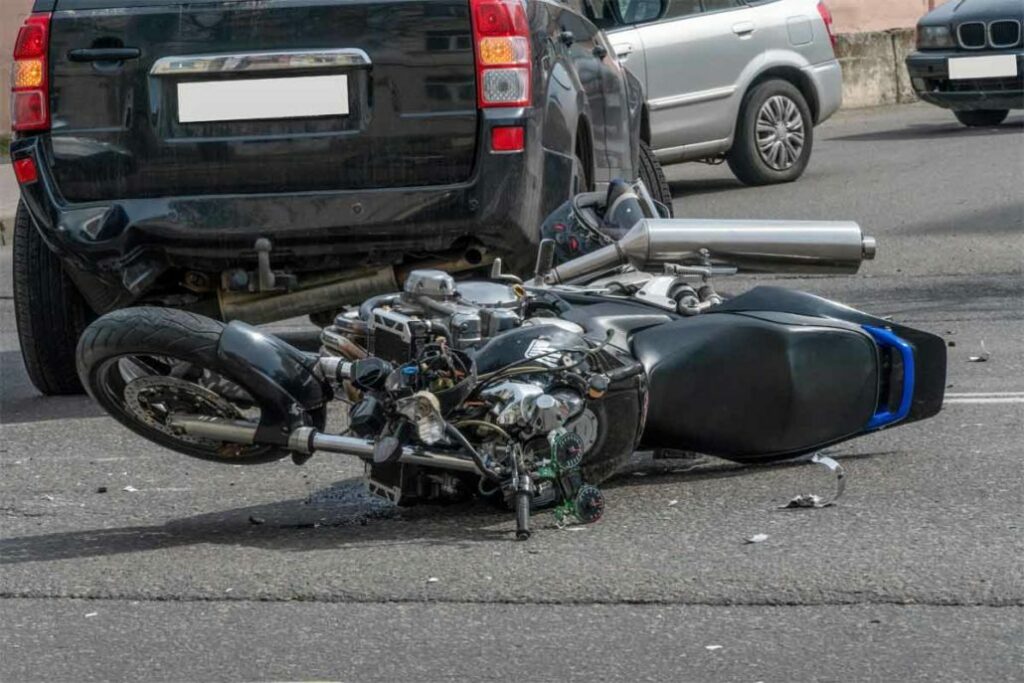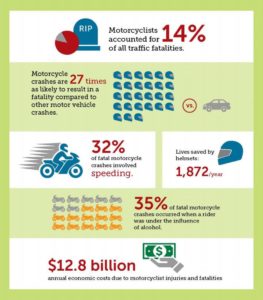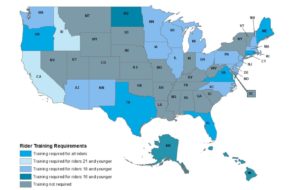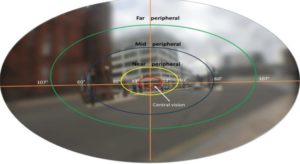No Pagas Hasta Ganar
No Pagas Hasta Ganar

Studies show that 14% of all traffic fatalities are motorcyclists. This means that, on average, 4,300 motorcyclists die from a motorcycle accident every year. It is no secret why motorcycle crashes are 27 times more likely to result in a fatality — motorcyclists are not protected by a passenger compartment, they do not have seatbelts or shoulder harnesses, and they do not have the benefit of airbags.
Making matters worse, there has been an upward trend in motorcycle ownership. An increase of 1.5 million more homes report owning at least one motorcycle. The MIC (Motorcycle Industry Council) reports the number of female riders has almost doubled in the last decade. Female riders now make up 19% of overall motorcycle owners and are projected to soon reach 25%.1 Riding is life — whether it’s the freedom of a long ride through back roads with the wind in your face, your heart pounding as you dip into a knee dragger on track day, or enjoying a quick ride on your daily commute. Some riders say «it is a way of life that, if an explanation is needed, odds are it won’t be understood.»
With this trend, there has been much debate about whether motorcycles crash more than passenger vehicles. Regardless of which side of the debate you fall, there is no denying that motorcyclists sustain higher rates of injury or death compared to passenger vehicle occupants. Gage Mathers Law Group has represented many riders who have been victims of motorcycle accidents. We have seen the devastating effects on the lives of riders and their loved ones. A rider’s injuries can range from minor abrasions and soreness to broken bones, degloving injuries, severe road rash, traumatic brain injuries, and death.

Quick Motorcycle Accident Stats
By mere design, motorcycles have a steep disadvantage to your typical passenger vehicle when it comes to protection. The very things that make motorcycles so thrilling are precisely what heighten the probability of injury or death. Whether it’s the open-air nature and exposure to the elements or the power-to-weight ratio that can make a bike faster than a 6-figure sports car, motorcyclists require a set of skills that are not learned in high school driver’s ed. These skills can range from balancing the bike while coming to a full stop to proper synchronization while emergency braking using both front and rear brakes while downshifting. These are skills that need to be acquired and refined to operate a bike proficiently and safely. For this reason, all states require a license or endorsement specifically for motorcycles.

Required Training for New Licensees
In comparison to motorcycles, drivers of passenger vehicles only need to develop minimal new skills to operate their vehicles safely. In fact, Artificial Intelligence (AI) is transforming passenger vehicles into computers on wheels. One day, driver input could become unnecessary. By 2025, we can expect approximately 8 million autonomous or semi-autonomous vehicles on the road. Along with its ease of use, you also have the added protection of being enclosed and surrounded by multiple layers of metal, well-designed safety features like airbags, and accident-avoidance systems. Particularly with modern vehicles, like the Tesla Model X, the safety rating can reach a full 5 stars. This minimal learning curve and protective measures help mitigate potential injuries car occupants may sustain. These same benefits may cause driver over-confidence making the road more dangerous for motorcyclists.
Considering that 75% of motorcycle crashes occur with a passenger vehicle, and a majority of those happen at intersections when the motorcyclist’s right-of-way is violated, it’s easy to see that rider visibility can be a major contributor to motorcycle crashes.

the moment the motorcycle accident occurred
For a motorcyclist, it may take many hours of riding, thousands of miles covered, or advanced riding courses and track days before a rider can be properly proficient on a motorcycle. This of course depends on the rider. Proficiency and preparedness can have major implications on rider safety.
One common reason for avoidable crashes is “survival reactions” or instinctual actions taken out of fear or panic. Unfortunately, for motorcyclists, survival reactions are a sure way to crash. However, through proper training, these instincts can be honed to minimize the risk of a crash.
About 25% of motorcycle crashes are single-vehicle accidents, with two-thirds of those due to rider error. Most of these are riders in a low-side crash or “laying down” their bike in a corner because of improper speed, under or over steering, and object fixation.
When considering that humans lose 90% of their vision at 20 degrees off their central vision to peripheral blindness, it’s no surprise that motorcycles are lost in a passenger vehicle driver’s peripheral vision. Motorcycles have a much smaller and thinner profile than passenger vehicles and can easily blend into the surroundings.

This loss of vision isn’t usually noticed because the driver’s brain «fills in» what it thinks should be there using information from previous trips through that same area. This psychological phenomenon helps explain why most car accidents occur close to home — people’s brain switch to autopilot because familiar surroundings reinforce the belief that the driver knows what to expect.
Therefore, ride as if you are invisible and surrounded by blind people driving. “Invisibility Training for Motorcyclists” is a great video that talks about peripheral blindness and gives some suggestions that you can apply to minimize the probability of being involved in a crash.
It is no surprise that 92% of riders involved in a crash are either self-taught or learned from a family member or friend. Riders aged 16-24 years are significantly overrepresented in motorcycle crashes. One of the best ways that you can minimize the chance of a crash is by becoming the most competent rider possible. Riding is a skill that requires much more attention and effort than driving a car. We suggest you get any advanced training available beyond what is required by your state.
Most, if not all, states offer advanced riding classes to refine and improve your skills as a rider. There are many classes offered by locally-owned dealerships or motorcycle companies, like the Harley-Davidson Riding Academy, that will help you increase your comfort level and capabilities. If you get a new bike, take a class with that bike. More than half of the riders in an accident had less than 5 months of experience with the bike involved in the crash.
At a time when information is a Google search away, now more than ever riders have access to advanced training, tips, and clubs that foster rider competence and safety. If paying for or attending a class is difficult, a much loved movie, “Twist of the Wrist II” is a great place to start. Based on the book by the same name, both are considered to be a high-performance rider’s bible. Written by the legendary Keith Code, who also founded the California Superbike School, both the book and movie detail simple yet lifesaving skills such as counter steering. Wherever you ride, careful, repetitive use and application of the skills provided in these resources is an inexpensive way to begin honing your skills. Learning proper throttle control, braking and alertness, and proper motorcycle safety checks can ensure you don’t become another motorcycle rider statistic.
As your skills improve, your riding naturally becomes safer and more enjoyable. You instinctively apply previously learned and developed skills that can turn a certain collision into a close call.
Helmet Laws by State as of 2019
(Chandler, Scottsdale, Paradise Valley, Tempe, Mesa, Queen Creek, Fountain Hills, Peoria, Goodyear, etc.)
These days, the majority of U.S. states have universal or partial helmet laws. This runs contrary to bike culture ideologies and myths. Many riders may claim that their vision or hearing is diminished when wearing one; however, motorcycle accident safety studies support the contrary. There is resistance by many riders, objecting to mandatory helmet laws and suggesting real men don’t wear helmets, but the fact is a helmet provides better protection than nothing at all and may one day save your life.
How to Save a Motorcyclist’s Life
You might want to consider riding with a friend, especially when venturing out to rural areas. This can ensure that there is someone with you who can render aid and get help should a crash occur. Another Gage Mathers team member was quadding in the dunes when her family came across a rider several hours after they had crashed. He was solo and suffered a fatal injury. He might have survived if another driver was with him.
We always like to remind people that they are responsible for their own safety. Whether a motorcyclist or in a passenger vehicle, there are small things that each of us can do to protect ourselves and those around us. For instance, avoid distractions like cell phones, be aware of your surroundings, and practice safe driving or riding skills. These simple, common sense measures can significantly reduce the risk of having an accident or being injured in one.
Personal Injury & Accident Lawyers in Arizona
Speak to one of our personal injury attorneys and learn more about the legal options for your accident claim.
Sadly, no matter how many precautions you take, the possibility of being involved in a motorcycle accident will always be present. Much like being properly prepared to avoid an accident and mitigating injuries with gear, what you do after an accident is equally as important.
Whether you are the rider or a driver who happens to be present when a motorcycle crash occurs, there are things you can do that may save a rider’s life. At the very minimum, call 911-get an ambulance and emergency medical services there as soon as possible.
Motorcycle crash victims almost always hit their head and tweak their neck. Leave their helmet on and keep them as still as possible. As a rider, you can take additional precautions by packing a basic trauma kit with items like trauma pads (to control bleeding) and tourniquets (to cut off blood supply if an arm or leg is bleeding uncontrollably). Such precautions could mean the difference between life and death.
After a motorcycle accident, check yourself immediately for the following injuries:
Along with these precautions, make sure you have a knowledgeable attorney on your side. The last thing you want to do after being injured is having to deal with apathetic adjusters who are paid to save their insurance company money. These adjusters are rewarded for nickel and diming you. They do not receive praise for making your life easier. They do not care about your struggles. This adds insult to injury.
As well-trained and highly experienced motorcycle accident attorneys, we can lift this burden off the shoulders of you and your family. This allows you to focus on your recovery while we maximize your compensation.
Si usted o algún ser querido ha sido lesionado seriamente, por favor llene el siguiente formulario para recibir una consulta gratuita o llame al (602) 258-0646
2525 E Arizona Biltmore Cir #A114, Phoenix, AZ 85016
direcciones